Related Research Articles
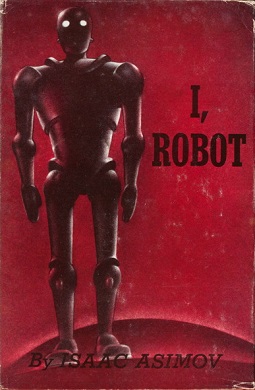
I, Robot is a fixup collection made up of science fiction short stories by American writer Isaac Asimov. The stories originally appeared in the American magazines Super Science Stories and Astounding Science Fiction between 1940 and 1950 and were then collected into a 1950 publication Gnome Press in 1950, in an initial edition of 5,000 copies.

Roger William Corman is an American film director, producer, and actor. Known under various monikers such as "The Pope of Pop Cinema", "The Spiritual Godfather of the New Hollywood", and "The King of Cult", he is known as a trailblazer in the world of independent film. Many of Corman's films are low-budget cult films including some which are adapted from the tales of Edgar Allan Poe.

American International Pictures is an American motion picture production label of Metro-Goldwyn-Mayer, owned by Amazon MGM Studios. In its original operating period, AIP was an independent film production and distribution company known for producing and releasing films from 1955 until 1980, a year after its acquisition by Filmways in 1979.
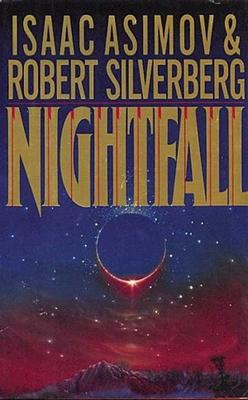
"Nightfall" is a 1941 science fiction short story by the American writer Isaac Asimov about the coming of darkness to the people of a planet ordinarily illuminated by sunlight at all times. It was adapted into a novel with Robert Silverberg in 1990. The short story has been included in 48 anthologies and has appeared in six collections of Asimov's stories. In 1968, the Science Fiction Writers of America voted "Nightfall" the best science fiction short story written prior to the 1965 establishment of the Nebula Awards and included it in The Science Fiction Hall of Fame Volume One, 1929–1964.
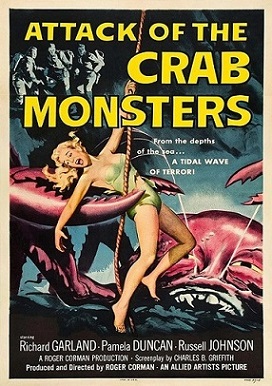
Attack of the Crab Monsters is a 1957 independently made American black-and-white science fiction-horror film, produced and directed by Roger Corman, that stars Richard Garland, Pamela Duncan, and Russell Johnson. The film was distributed by Allied Artists as a double feature showing with Corman's Not of This Earth.

The Undead is a 1957 horror film directed by Roger Corman and starring Pamela Duncan, Allison Hayes, Richard Garland and Val Dufour. It also featured Corman regulars Richard Devon, Dick Miller, Mel Welles and Bruno VeSota. The authors' original working title was The Trance of Diana Love. The film follows the story of a prostitute, Diana Love (Duncan), who is put into a hypnotic trance by psychic Quintus (Dufour), thus causing her to regress to a previous life. Hayes later starred in Attack of the 50 Foot Woman (1958). The film was released on March 15, 1957 by American International Pictures as a double feature with Voodoo Woman.
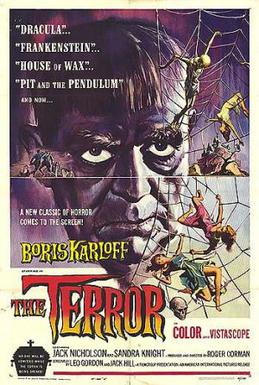
The Terror is a 1963 American independent horror film produced and directed by Roger Corman. The film stars Boris Karloff and Jack Nicholson, the latter of whom portrays a French officer who is seduced by a woman who is also a shapeshifting devil.
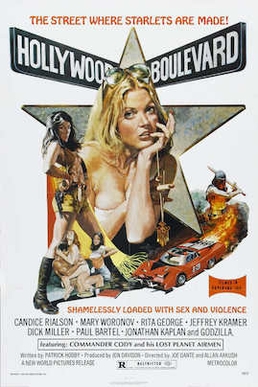
Hollywood Boulevard is a 1976 American satirical exploitation film directed by Allan Arkush and Joe Dante, and starring Candice Rialson, Paul Bartel, and Mary Woronov. It follows an aspiring actress who has just arrived in Los Angeles, only to be hired by a reckless B movie film studio where she bears witness to a series of gruesome and fatal on-set accidents. The film blends elements of the comedy, thriller, and slasher film genres.

Charles Byron Griffith was an American screenwriter, actor, and film director. He was the son of Donna Dameral, radio star of Myrt and Marge, along with Charles' grandmother, Myrtle Vail, and was best known for writing Roger Corman productions such as A Bucket of Blood (1959), The Little Shop of Horrors (1960), and Death Race 2000 (1975).

Day the World Ended is a 1955 independently made black-and-white post-apocalyptic science fiction film, produced and directed by Roger Corman, that stars Richard Denning, Lori Nelson, Adele Jergens, Paul Birch (actor) and Mike Connors. Chet Huntley of NBC, later of The Huntley-Brinkley Report, served as the film's narrator. It was released by American Releasing Corporation as a double feature with The Phantom from 10,000 Leagues.
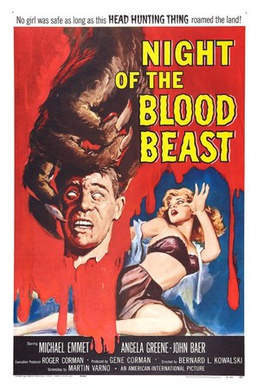
Night of the Blood Beast is a 1958 American science-fiction horror film about a team of scientists who are stalked by an alien creature, which implants its embryos in an astronaut's body during a space flight. Produced by exploitation filmmaker Roger Corman and his brother Gene, it was one of the first films directed by Bernard L. Kowalski and was written by first-time screenwriter Martin Varno, who was 21 years old. It starred several actors who had regularly worked with Roger Corman, including Michael Emmet, Ed Nelson, Steve Dunlap, Georgianna Carter and Tyler McVey. The film was theatrically released in December 1958 as a double feature with She Gods of Shark Reef.

Monster from the Ocean Floor is an American 1954 science fiction film about a sea monster that terrorizes a Mexican cove. The film was directed by Wyott Ordung and starred Anne Kimbell and Stuart Wade.

Not of This Earth is a 1988 American science fiction horror comedy film, directed by Jim Wynorski and starring Traci Lords in her first mainstream role after her departure from the adult film industry. It is a remake of Roger Corman's 1957 film of the same name, written by Charles B. Griffith and Mark Hanna.

Rock All Night is a 1957 crime drama film produced and directed by Roger Corman. Distributed by American International Pictures, it is based on a 25-minute television episode of The Jane Wyman Show from 1955 called "The Little Guy." It stars Dick Miller, Russell Johnson and Abby Dalton. It co-stars Mel Welles, Ed Nelson and Clegg Hoyt. The film was released as a double feature with Dragstrip Girl.

Machine-Gun Kelly is a 1958 film noir directed by Roger Corman that chronicles the criminal activities of the real-life George "Machine Gun" Kelly. Despite its low budget, the film received positive critical reviews.
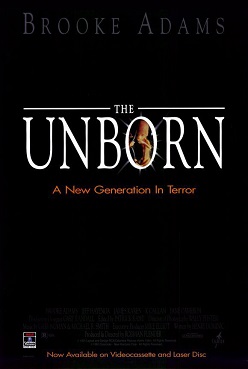
The Unborn is a 1991 American science fiction horror film directed by Rodman Flender and starring Brooke Adams, Jeff Hayenga, James Karen, K Callan, and Jane Cameron. The film's plot concerns a couple who cannot have children; they attempt in-vitro fertilization, but strange things start happening to the mother while she is pregnant.

Night Call Nurses is a 1972 American sex comedy film directed by Jonathan Kaplan. It is the third in Roger Corman's "nurses" cycle of films, starting with The Student Nurses (1970).

The Saga of the Viking Women and Their Voyage to the Waters of the Great Sea Serpent is a 1958 American action-adventure horror film directed by Roger Corman. It stars Abby Dalton, Susan Cabot and June Kenney.
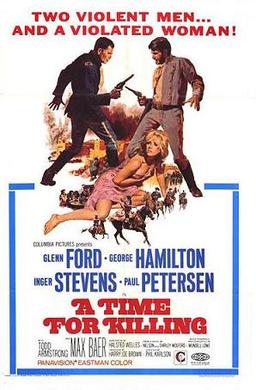
A Time for Killing is a 1967 Western film directed originally by Roger Corman but finished by Phil Karlson. Filmed in Panavision and Pathécolor, it stars Glenn Ford, George Hamilton, Inger Stevens, and Harrison Ford in his first credited film role.

The Woman Hunt is a 1972 film directed by Eddie Romero and starring John Ashley, Pat Woodell, and Sid Haig.
References
- ↑ Counts p 62
- ↑ Counts p 60
- ↑ Lee, G. (Aug 29, 1980). "CORMAN: SHOESTRINGS AND CANNY GUESSES". Los Angeles Times. ProQuest 162892380.
- ↑ Counts p 60
- ↑ Caulfield, D. (May 15, 1986). "ANOTHER CORMAN HEARD FROM". Los Angeles Times. ProQuest 154619860.
- ↑ Counts p 61
- ↑ Counts p 62
- ↑ Counts p 61
- ↑ Counts p 62
- ↑ Counts p 62
- ↑ Counts p 62
- ↑ Counts p 62
- ↑ Willman, Chris (September 26, 1988). "MOVIE REVIEW : 'Nightfall': A Classic Asimov Tale Gone Bad". Los Angeles Times.
- ↑ "Interview with Roger Corman & Julie Corman of DINOCROC VS. SUPERGATOR". TV Tango. 25 June 2010.
- Counts, Kyle (September 1988). "Watching the Nightfall". Starlog (134 ed.).